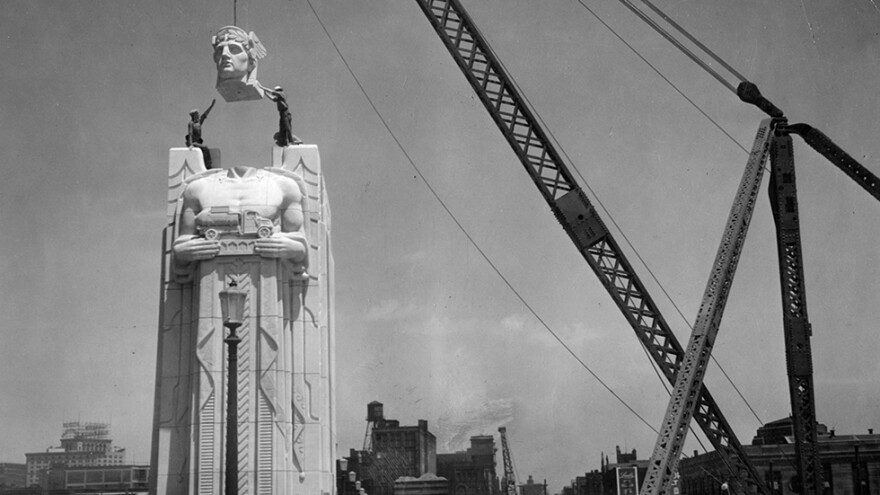Updated July 23, 2021 at 1 p.m.
Editor's note: Cleveland's Major League Baseball team has announced it will change its name to the Guardians after the 2021 season. The inspiration for that name comes from the iconic "Guardians of Traffic" on the Lorain-Carnegie Bridge, not far from Progressive Field where the team plays.
Ideastream Public Media's Carrie Wise examined the history and popularity of the Guardians in this 2018 piece. It helps explain why the team made its choice.
Images of the larger-than-life Art Deco statues above Cleveland’s Lorain-Carnegie Bridge are popping up all around the city.
One of the latest spots is as a replacement for LeBron’s image on the banner that hangs on the Sherwin Williams building outside Quicken Loans Arena. As the season starts this month, the Cleveland Cavaliers will hang a new banner featuring a mosaic of fan photos in the shape of one of the Guardians of Traffic.
Rendering of new banner [Cleveland Cavaliers]
Images of the guardians appear on everything from posters to T-shirts to shower curtains.
Artist Christina Sadowski sells a variety of guardian-inspired pieces, including pillows, yoga leggings and charm bracelets.
“There’s something about them that people just love, and it says home to them,” she said.
She first photographed them about 10 years ago for a class project while a student at Baldwin Wallace University. That kicked off a love for Cleveland imagery, which has continued with the guardians playing a major role.
On a recent Sunday morning, Sadowski headed out onto the bridge to snap some new images of the guardians as the sun rose over the city.
“They’re beautiful but challenging to shoot,” Sadowski said.
Christina Sadowski captures photos of the Guardians of Traffic on an early Sunday morning
The bridge’s guardians are icons for the city, imagined nearly a century ago, when Cleveland was the fifth largest city in the nation.
“They produced a structure that I think was memorable then and memorable now,” said John Grabowski, editor of the “Encyclopedia of Cleveland History” and a history professor at Case Western Reserve University.
“There were calls for a bridge going back to 1903,” Grabowski said. “In the 1920s when the city was booming, its traffic problems were exacerbated, and so there was a bond issue passed and construction of the bridge began in 1929, just before the crash.”
The bridge’s design team included civil engineer Wilbur J. Watson, architect Frank Walker and sculptor Henry Hering. Stonemasons carved eight Art Deco figures in Berea sandstone on four pylons located at the corners of the bridge. Each guardian holds a different mode of transportation in his hands.
“They are monumental structure, they are figures that rise above the actual structure. And if you look around Cleveland then and now, I mean you’re not going to find any representational art that is that large,” Grabowski said.
Stonemasons pose with one of the guardians [Cleveland Memory Project]
The bridge was completed in 1932, but by the 1970s the Guardians of Traffic were threatened with calls for demolition.
“The bridge had gotten old, they were dirty,” Grabowski said.
Ultimately, they were cleaned in the 80s, and remain highly visible today at the entrance to downtown.
While the structures are also often reffered to as Guardians of Transportation, officially they are the Guardians of Traffic, Grawbowski said.
Paul Duda in his Tremont gallery
The guardians have been frequent subject matter for another local artist, Paul Duda. When you step inside his Tremont gallery, the guardians hang prominently among beautiful landscapes of the city.
“People here feel that the area is somehow fundamentally flawed. So I wanted to help break down that internalized negativity about the area so people could feel good about their homes,” Duda said.
They also remind people of the city’s legacy.
“You want to preserve all those things we will never be able to build again,” Duda said.
Artist Jim Lanza also celebrates iconic Cleveland imagery in his work, which features photos printed on wood.
“The grain of the wood becomes part of the art, and I do things like burning it with a propane torch to give it sort of a vintage look,” he said.
Lanza said he has seen strong interest in his guardian pieces and an increase in general in the use of them as symbols for the city.
Jim Lanza works on one of his wood prints
He has even met people with ties to the bridge’s history.
“I’ve been lucky enough to meet about, I think, five or six descendants from the stonecutters,” he said. “One of the people I met recently was Bob Hope’s grandnephew actually at an art show in Chardon.”
Comedian Bob Hope’s father was one of the stonemasons who worked on the bridge, and in the 1980s it was renamed Hope Memorial Bridge in his honor.
Decades later, the faces of the guardians seem to appear everywhere you look.
“They’re now on, you know, beer bottle labels to t-shirts and a lot of artwork at a lot of the fests that I do, and I think because of that people have become more aware of them,” Lanza said.
They also remain in a prominent place at the entrance to downtown.
“I think people are now paying attention a little more to what’s going on downtown, got some livelihood down here and kind of a rebirth of the city,” Sadowski said.
View of the bridge in the early morning










